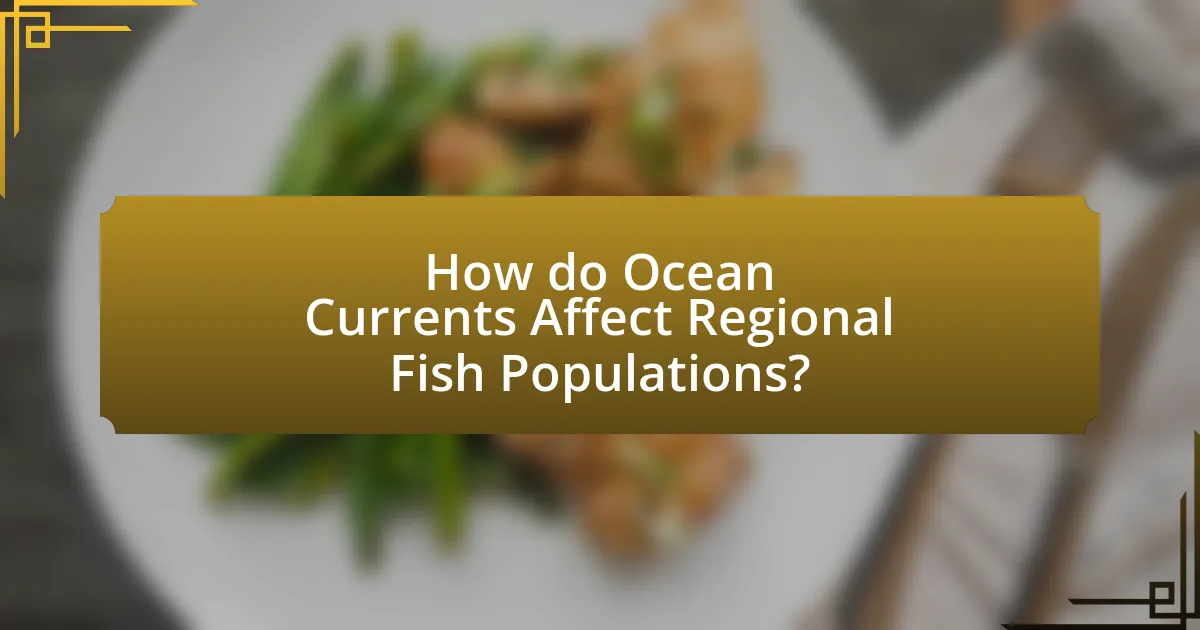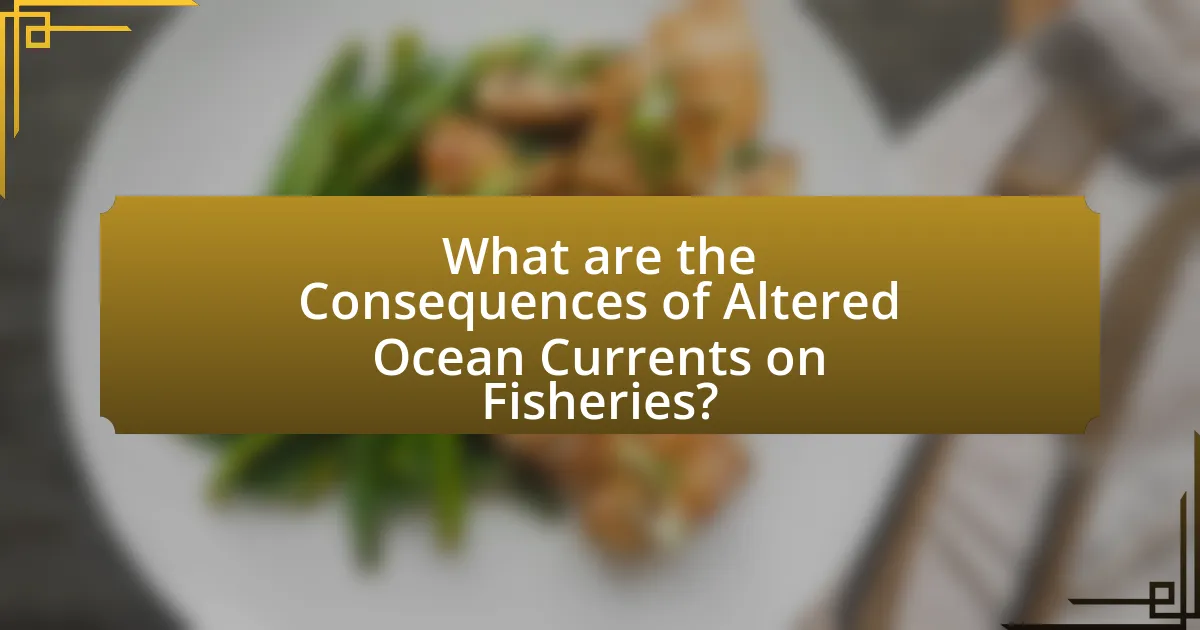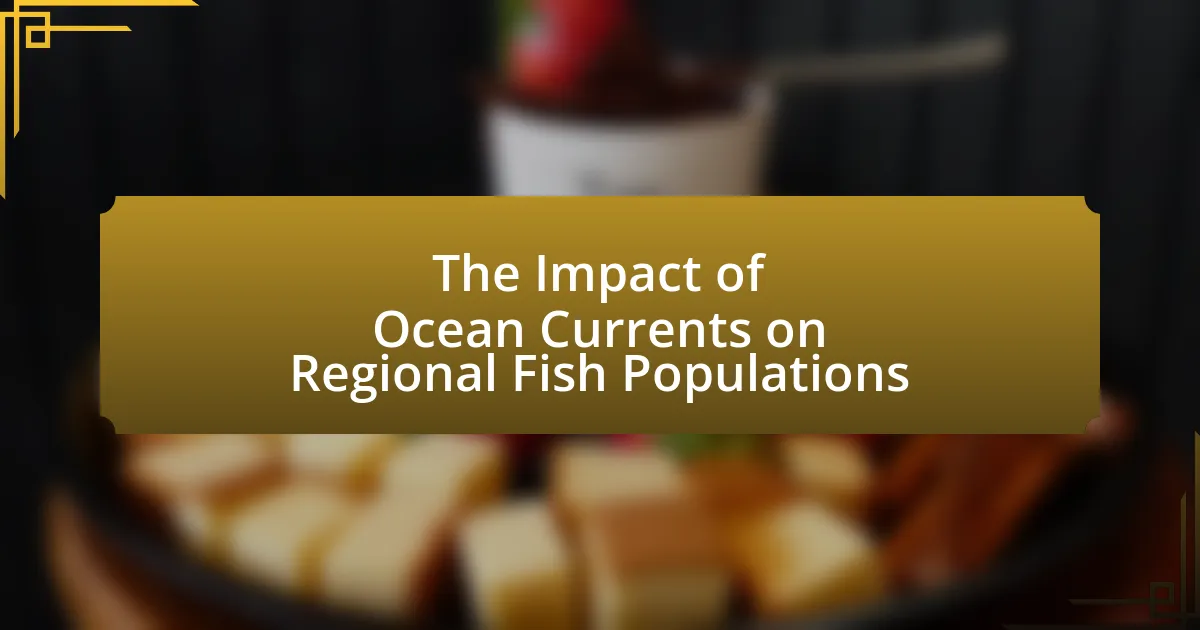Ocean currents are large-scale flows of seawater that significantly influence regional fish populations by affecting their distribution, breeding, and feeding patterns. This article examines the formation and types of ocean currents, including surface and deep-water currents, and their critical role in nutrient distribution and marine ecosystems. It highlights how temperature and salinity impact these currents, the implications of current changes on fish populations, and the economic effects on fisheries and local communities. Additionally, the article discusses conservation strategies and sustainable fishing practices that can mitigate the impact of changing currents on vulnerable fish populations.

What are Ocean Currents and Their Role in Marine Ecosystems?
Ocean currents are large-scale flows of seawater that move through the world’s oceans, driven by factors such as wind, temperature differences, and the Earth’s rotation. These currents play a crucial role in marine ecosystems by regulating climate, distributing nutrients, and influencing the migration patterns of marine species. For instance, the Gulf Stream transports warm water from the Gulf of Mexico to the North Atlantic, affecting weather patterns and supporting diverse marine life. Additionally, upwelling zones, where deep, nutrient-rich waters rise to the surface, are vital for sustaining high productivity and biodiversity in marine ecosystems, directly impacting regional fish populations by providing essential nutrients for phytoplankton, which form the base of the marine food web.
How do ocean currents form and what factors influence them?
Ocean currents form primarily due to the wind, the Earth’s rotation, and differences in water density. Wind-driven currents occur when surface winds push water, creating friction that generates movement. The Coriolis effect, resulting from the Earth’s rotation, causes currents to curve, influencing their direction. Additionally, variations in water temperature and salinity create density differences, leading to thermohaline circulation, which drives deep ocean currents. These factors collectively shape the patterns and strength of ocean currents, impacting marine ecosystems and regional fish populations by affecting nutrient distribution and habitat availability.
What are the primary types of ocean currents?
The primary types of ocean currents are surface currents and deep-water currents. Surface currents, which occur in the upper layer of the ocean, are primarily driven by wind patterns and the Earth’s rotation, influencing climate and marine ecosystems. Deep-water currents, also known as thermohaline circulation, are driven by differences in water density, which is affected by temperature and salinity, playing a crucial role in global heat distribution and nutrient transport. These currents significantly impact regional fish populations by affecting their migration patterns, breeding grounds, and food availability.
How do temperature and salinity affect ocean currents?
Temperature and salinity significantly influence ocean currents by affecting water density, which drives the movement of water masses. Warmer water is less dense than colder water, causing it to rise, while saltier water is denser than fresher water, causing it to sink. This interplay creates a global conveyor belt of currents, known as thermohaline circulation, which is crucial for regulating climate and nutrient distribution in marine ecosystems. For instance, the Atlantic Meridional Overturning Circulation, a key component of global ocean currents, is driven by variations in temperature and salinity, impacting weather patterns and marine life across different regions.
Why are ocean currents important for marine life?
Ocean currents are crucial for marine life because they facilitate nutrient distribution, regulate temperature, and support migration patterns. These currents transport essential nutrients from the deep ocean to the surface, promoting phytoplankton growth, which forms the base of the marine food web. For instance, the upwelling zones along coastlines, driven by currents, are known for their high productivity, supporting diverse fish populations. Additionally, ocean currents influence the habitats of various marine species by maintaining suitable temperatures and salinity levels, which are vital for their survival and reproduction. Studies have shown that changes in ocean currents can significantly impact fish populations, as seen in the decline of certain species linked to altered current patterns due to climate change.
How do ocean currents impact nutrient distribution?
Ocean currents significantly influence nutrient distribution by transporting nutrient-rich waters from deeper ocean layers to the surface, a process known as upwelling. This upwelling occurs in various regions, particularly along coastlines, where winds push surface waters away, allowing deeper, nutrient-dense waters to rise. For instance, the California Current and the Humboldt Current are well-documented examples where upwelling supports high biological productivity, leading to abundant fish populations. Studies have shown that areas with strong upwelling, such as the eastern boundary currents, can have nutrient concentrations that are several times higher than surrounding waters, directly enhancing the availability of nutrients for phytoplankton, which forms the base of the marine food web.
What role do ocean currents play in fish migration patterns?
Ocean currents significantly influence fish migration patterns by directing the movement of fish species across vast distances. These currents create pathways that fish use to travel between breeding and feeding grounds, often aligning with seasonal changes in water temperature and nutrient availability. For instance, species like salmon rely on specific currents to navigate from freshwater spawning areas to the ocean and back, demonstrating the critical role of currents in their life cycle. Research indicates that ocean currents can affect the distribution of fish populations, as seen in studies showing that changes in current patterns due to climate change can lead to shifts in fish stocks, impacting both ecological balance and fisheries.

How do Ocean Currents Affect Regional Fish Populations?
Ocean currents significantly influence regional fish populations by affecting their distribution, breeding, and feeding patterns. These currents transport nutrients and plankton, which are essential for fish survival, to different areas, thereby enhancing productivity in those regions. For instance, the California Current brings nutrient-rich waters from the deep ocean to the surface, supporting diverse marine life, including commercially important fish species like sardines and anchovies. Additionally, ocean currents can create upwelling zones, where cold, nutrient-dense water rises to the surface, further boosting fish populations. Studies have shown that regions with strong upwelling, such as the Humboldt Current off the coast of South America, experience higher fish biomass compared to areas with weaker currents.
What specific fish populations are influenced by ocean currents?
Specific fish populations influenced by ocean currents include Atlantic cod, Pacific salmon, and sardines. These species rely on ocean currents for migration, spawning, and feeding. For instance, Atlantic cod populations are affected by the Gulf Stream, which influences their distribution and breeding grounds. Similarly, Pacific salmon utilize currents for their upstream migration to spawning rivers, while sardines are known to follow nutrient-rich upwellings driven by ocean currents, impacting their population dynamics.
How do currents affect spawning and breeding grounds for fish?
Currents significantly influence spawning and breeding grounds for fish by affecting the distribution of nutrients and the movement of eggs and larvae. Strong currents can transport fertilized eggs away from their original spawning sites, impacting survival rates and recruitment to adult populations. For instance, studies have shown that species like salmon rely on specific current patterns to ensure their eggs are deposited in suitable habitats, which are often rich in food resources. Additionally, currents can create upwelling zones that enhance nutrient availability, promoting the growth of phytoplankton, which serves as a food source for larval fish. This relationship between currents and nutrient dynamics is crucial for the successful reproduction and growth of various fish species.
What are the implications of current changes on fish population dynamics?
Current changes in ocean currents significantly affect fish population dynamics by altering habitat availability, food distribution, and reproductive patterns. For instance, shifts in currents can lead to changes in water temperature and salinity, which directly influence the spawning and migration behaviors of various fish species. Research indicates that species such as cod and herring have experienced population declines due to altered spawning grounds resulting from changing currents. Additionally, the displacement of nutrient-rich waters can impact the availability of prey, further affecting fish populations. These dynamics underscore the interconnectedness of oceanographic changes and marine biodiversity, highlighting the need for adaptive management strategies in fisheries.
How do seasonal variations in ocean currents impact fish populations?
Seasonal variations in ocean currents significantly impact fish populations by influencing their distribution, breeding, and feeding patterns. For instance, warmer currents during spring and summer can lead to increased nutrient availability, promoting plankton growth, which serves as a food source for many fish species. Research indicates that species such as sardines and anchovies migrate towards these nutrient-rich areas, enhancing their reproductive success. Conversely, colder currents in autumn and winter can lead to decreased food availability, causing some fish populations to migrate to warmer waters or deeper depths to survive. Studies have shown that these migrations are crucial for maintaining the balance of marine ecosystems, as they affect predator-prey relationships and overall biodiversity.
What are the effects of El Niño and La Niña on fish populations?
El Niño and La Niña significantly affect fish populations by altering ocean temperatures and currents. During El Niño events, warmer waters can lead to decreased nutrient availability, resulting in reduced fish populations, particularly in regions like the eastern Pacific where upwelling is diminished. Conversely, La Niña typically brings cooler waters and enhanced upwelling, which can increase nutrient levels and support larger fish populations, as observed in areas like the California coast. Studies have shown that these phenomena can lead to shifts in species distribution, with some fish migrating to cooler waters during El Niño and thriving in the nutrient-rich conditions of La Niña.
How do long-term climate changes alter ocean currents and fish populations?
Long-term climate changes significantly alter ocean currents and fish populations by affecting water temperature, salinity, and nutrient distribution. For instance, rising global temperatures can lead to changes in the density and flow of ocean water, which in turn modifies established current patterns. These altered currents can disrupt the migration routes of fish species, impacting their breeding and feeding grounds. Research indicates that shifts in ocean currents due to climate change have already led to changes in fish distribution, with species like cod and haddock moving to cooler waters, as documented in studies by the National Oceanic and Atmospheric Administration (NOAA). Additionally, changes in nutrient availability caused by altered currents can affect primary productivity, which is crucial for sustaining fish populations.

What are the Consequences of Altered Ocean Currents on Fisheries?
Altered ocean currents significantly impact fisheries by disrupting fish migration patterns and affecting nutrient distribution. Changes in currents can lead to shifts in the locations where fish spawn and feed, resulting in decreased fish populations in traditional fishing areas. For instance, studies have shown that the warming of ocean waters and changes in currents can lead to a decline in species such as cod in the North Atlantic, where historically stable currents have shifted. Additionally, altered currents can affect the upwelling of nutrient-rich waters, which is crucial for the growth of phytoplankton, the foundation of the marine food web. This disruption can lead to lower fish stocks and economic losses for fishing communities reliant on stable fish populations.
How do changes in ocean currents affect commercial fishing industries?
Changes in ocean currents significantly impact commercial fishing industries by altering the distribution and abundance of fish populations. Ocean currents influence water temperature, nutrient availability, and the migration patterns of fish species. For instance, the 2015-2016 El Niño event caused shifts in ocean temperatures and currents, leading to decreased fish catches in regions like Peru, where anchovy populations declined by over 90% due to unfavorable conditions. Additionally, changes in currents can affect spawning grounds and feeding areas, further disrupting local fisheries. These dynamics highlight the critical relationship between ocean currents and the viability of commercial fishing operations.
What are the economic impacts of shifting fish populations on local communities?
Shifting fish populations significantly impact local communities economically by altering fishing yields and affecting livelihoods. As fish migrate due to changing ocean currents and temperatures, communities that rely on specific fish species for income may experience reduced catches, leading to decreased revenue for fishermen and associated businesses. For instance, a study by the National Oceanic and Atmospheric Administration (NOAA) found that shifts in fish populations can lead to a 20% decline in catch for some coastal communities, directly affecting local economies dependent on fishing. Additionally, changes in fish availability can disrupt local markets, increase competition among fishermen, and necessitate costly adaptations in fishing practices, further straining economic stability in these communities.
How can fisheries adapt to changes in ocean current patterns?
Fisheries can adapt to changes in ocean current patterns by implementing flexible management strategies and utilizing technology for real-time data analysis. Flexible management allows fisheries to adjust catch limits and fishing locations based on shifting fish populations influenced by altered currents. For instance, the North Atlantic fishery has seen success in adapting to changing currents by adjusting quotas based on stock assessments that reflect current conditions. Additionally, technologies such as satellite tracking and oceanographic models provide critical data that help fisheries anticipate changes in fish distribution, enabling them to make informed decisions. This adaptability is essential as studies indicate that ocean currents significantly affect the migration and spawning patterns of fish species, directly impacting regional fish populations.
What conservation strategies can mitigate the impact of changing currents on fish populations?
Conservation strategies that can mitigate the impact of changing currents on fish populations include the establishment of marine protected areas (MPAs), habitat restoration, and adaptive management practices. Marine protected areas help sustain fish populations by providing safe breeding grounds and reducing fishing pressure, which is crucial as currents shift habitats and food availability. Habitat restoration, such as rebuilding coral reefs and mangroves, enhances resilience against changing currents and supports diverse marine life. Adaptive management practices involve monitoring fish populations and currents to adjust fishing regulations and conservation efforts in real-time, ensuring that strategies remain effective as environmental conditions evolve. These approaches are supported by research indicating that MPAs can lead to a 20-50% increase in fish biomass, demonstrating their effectiveness in maintaining fish populations amidst changing ocean dynamics.
How can sustainable fishing practices help protect vulnerable fish populations?
Sustainable fishing practices help protect vulnerable fish populations by ensuring that fishing activities do not exceed the reproductive capacity of these species. By implementing measures such as catch limits, seasonal closures, and gear restrictions, fisheries can reduce overfishing and allow fish populations to recover. For instance, the establishment of marine protected areas (MPAs) has been shown to increase fish biomass and biodiversity, as evidenced by a study published in “Nature” by Edgar et al. (2014), which found that MPAs can lead to a 446% increase in fish populations over time. These practices not only support the sustainability of fish stocks but also contribute to the overall health of marine ecosystems, which are influenced by ocean currents that affect the distribution and migration patterns of fish.
What role do marine protected areas play in supporting fish populations affected by currents?
Marine protected areas (MPAs) play a crucial role in supporting fish populations affected by currents by providing safe habitats that enhance fish survival and reproduction. These designated zones limit human activities such as fishing and habitat destruction, allowing fish populations to recover and thrive. Research indicates that MPAs can increase fish biomass by up to 600% compared to unprotected areas, as observed in studies conducted in various marine ecosystems. This increase in biomass is vital for maintaining healthy fish populations, especially in regions where ocean currents can disperse larvae and juvenile fish, ensuring that they have a stable environment to grow and reproduce.
What best practices can be implemented to monitor and manage fish populations affected by ocean currents?
To monitor and manage fish populations affected by ocean currents, implementing a combination of satellite tracking, environmental DNA (eDNA) analysis, and adaptive management strategies is essential. Satellite tracking allows researchers to follow the migratory patterns of fish, providing real-time data on their movements in relation to ocean currents. eDNA analysis enables the detection of fish species in various habitats, offering insights into population distribution and health without the need for physical capture. Adaptive management strategies involve continuously adjusting management practices based on new data and changing environmental conditions, ensuring that fish populations are effectively supported. These practices are validated by studies showing that satellite tracking can improve understanding of fish behavior and habitat use, while eDNA has been proven effective in monitoring biodiversity in aquatic ecosystems.

Leave a Reply